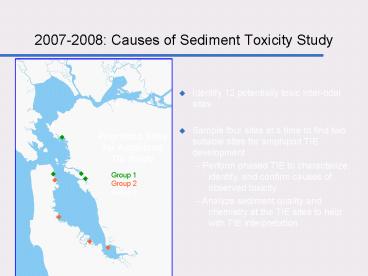20072008: Causes of Sediment Toxicity Study - PowerPoint PPT Presentation
1 / 11
Title:
20072008: Causes of Sediment Toxicity Study
Description:
... in San Francisco Bay. Management Context. Current Status ... Sediment Quality Objectives for bays and estuaries are proposed and will be promulgated soon ... – PowerPoint PPT presentation
Number of Views:42
Avg rating:3.0/5.0
Title: 20072008: Causes of Sediment Toxicity Study
1
2007-2008 Causes of Sediment Toxicity Study
w
- Identify 12 potentially toxic inter-tidal sites
- Sample four sites at a time to find two suitable
sites for amphipod TIE development - - Perform phased TIE to characterize, identify,
and confirm causes of observed toxicity - - Analyze sediment quality and chemistry at the
TIE sites to help with TIE interpretation
w
w
w
Prioritized Sites for Amphipod TIE Study
w
w
w
Group 1 Group 2 Group 3
w
w
w
w
w
2
Sediment Effects in San Francisco Bay
Management Context Current Status Important Work
to Date Sediment Toxicity Benthic Pilot
Study/SQO RMP Objectives and Management Questions
Addressed Five-Year Plan
EEPS WG Sep. 2007
3
Management Context
- Sediment toxicity is persistent in the Estuary
and we need to investigate the causes - Narrative toxicity objectives outlined in the
Basin Plan are employed by the Water Board to
list water bodies - Sediment Quality Objectives for bays and
estuaries are proposed and will be promulgated
soon
4
Current Status
- Persistent toxicity in Estuary sediments
- Toxicity in higher in the winter than the summer
- Toxicity in more prevalent in the margins than
channels - Benthic indices have been developed for some
benthic assemblages, and some benthic community
impacts are seen based on contamination - (However salinity and TOC were strong correlates
as well) - Benthic impacts are more prevalent in margins
than channels
5
Important Work to Date
- RMP Status and Trends continues to characterized
sediment toxicity conditions in the Estuary - Complex mixtures and specific contaminant groups
have been correlated to sediment toxicity
observed in the ST program - Bivalve and Amphipod TIEs are useful tools to
separate contaminant causes of toxicity - Benthic Assemblages have been characterized for
the Estuary - Benthic Indices developed within some of these
assemblages are employed by the SQO for bays and
estuaries
6
RMP Management Objectives Addressed
- Objective 4. Characterize ecological and human
health risk due to pollution of the Estuary
ecosystem - Objective 5. Use monitoring information to
compare to relevant regulatory guidelines (and to
establish new guidelines)
Page 8 of the draft workplan
7
Specific Questions to be Addressed in Next
Five-Years
- In order of priority
- What are the causes of sediment toxicity?
- Are Estuary sediments toxic?
- Are the benthos impacted by pollutants?
- Is the SQO method a valid way evaluate ecological
condition in this Estuary? - What are the causes of benthic impacts?
Page 8 of the draft workplan
8
Toxicity Workgroup Recommendations
- Evaluate toxicity during Winter near potential
sources - Follow the most relevant matrix (sediment)
- Investigate causes of persistent sediment
toxicity - Develop LC50s for estuarine species
- Integrate this study with Benthic work and other
SQO work that is planned
9
We have begun to address these questions
Causes of Sediment Toxicity
Causes of Benthic Impacts
ID Benthic Assemblages MQs 4.2, 5.1, 5.2 SQ 3 4
Bivalve TIEs MQ 4.1 SQ 1 2
Multivariate analyses to ID stressors MQs 4.2,
5.1, 5.2 SQ 1, 2, 3 5
Amphipod Dose Response Experiments MQ 4.1 SQ 1,
2, 3 5
Multi-metric Benthic Response Indices MQs 4.2,
5.1, 5.2 SQ 3, 4 5
SQO for bays and estuaries MQs 4.2, 4.4, 5.1, 5.2
MQs Management Questions addressed by the
study SQ Specific Question Addressed by the
Sediment Effects Studies See Page 8 of the
draft workplan Graphic is a modified version of
Figure 1 on Page 21
Amphipod TIEs MQ 4.1 SQ 1 2
Intensive triad studies at gradient sites to
investigate stressors MQs 4.1, 4.2 SQ 1,2,4 5
Experimental studies to understand benthic
community effects MQs 4.1, 4.2 SQ 3 5
Develop TIE toolbox to address causes MQ 4.1 SQ
1 2
Primary Objective Understand the Causes of
Ecological Effects in Sediments of the San
Francisco Estuary
Dose-response studies of both resident and lab
estuarine species using contaminant of concern MQ
4.1 SQ 1, 2, 3 5
10
Five-Year WorkplanSummary, Cost Estimates, and
MQs
Table 4 of the draft workplan On Page 18
11
Five-Year Workplan
Table 5 of the draft workplan On Page 19































